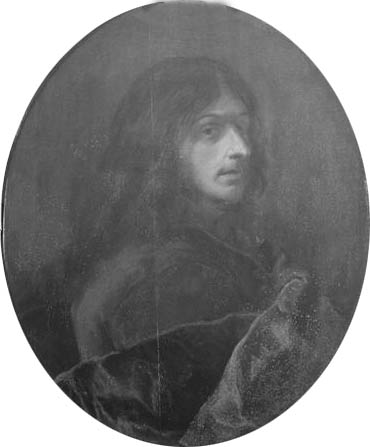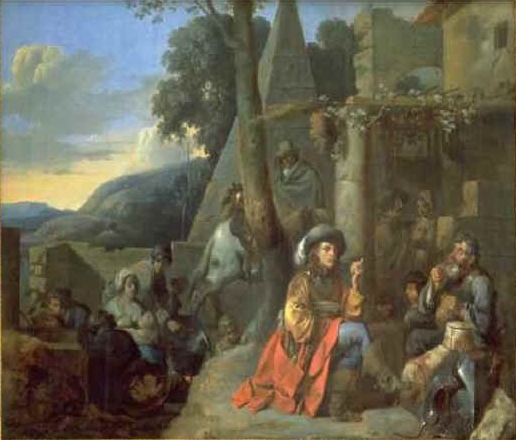Sébastien Bourdon on:
[Wikipedia]
[Google]
[Amazon]


 Sébastien Bourdon (2 February 1616 – 8 May 1671) was a French painter and engraver. His ''
Sébastien Bourdon (2 February 1616 – 8 May 1671) was a French painter and engraver. His ''
''Bourdon, Sébastien''
Grove Art Online. He lived in Paris from 1637 to 1652. In 1648, Bourdon was one of the founders of the French Royal Academy of Painting and Sculpture and was elected as one of the original twelve elders in charge of its running. In 1652 he departed for Sweden, where Queen
Sébastien Bourdon on-line
* ttps://web.archive.org/web/20060910021337/http://www.oberlin.edu/allenart/collection/bourdon_sebastien.html ''The Encampment'', c. 1636-38 (Oberlin College) A genre scene set in a fantastic landscape of lowering cliffs.
Portrait (engraving) of Sébastien Bourdon
by Laurent Cars at


 Sébastien Bourdon (2 February 1616 – 8 May 1671) was a French painter and engraver. His ''
Sébastien Bourdon (2 February 1616 – 8 May 1671) was a French painter and engraver. His ''chef d'œuvre
A masterpiece, ''magnum opus'' (), or ''chef-d’œuvre'' (; ; ) in modern use is a creation that has been given much critical praise, especially one that is considered the greatest work of a person's career or a work of outstanding creativity, ...
'' is ''The Crucifixion of St. Peter'' made for the cathedral of Notre Dame.
Biography
Bourdon was born in Montpellier, France, the son of a Protestant painter on glass. He was apprenticed to a painter in Paris. In spite of his poverty he managed to get to Rome in 1636. There he studied the paintings of masters such as Nicolas Poussin, Claude Lorrain and Caravaggio. He was forced to flee Rome in 1638, fearing prosecution for hisReformed Protestant
Calvinism (also called the Reformed Tradition, Reformed Protestantism, Reformed Christianity, or simply Reformed) is a major branch of Protestantism that follows the theological tradition and forms of Christian practice set down by John Calv ...
faith.Thierry Bayou''Bourdon, Sébastien''
Grove Art Online. He lived in Paris from 1637 to 1652. In 1648, Bourdon was one of the founders of the French Royal Academy of Painting and Sculpture and was elected as one of the original twelve elders in charge of its running. In 1652 he departed for Sweden, where Queen
Christina of Sweden
Christina ( sv, Kristina, 18 December ( New Style) 1626 – 19 April 1689), a member of the House of Vasa, was Queen of Sweden in her own right from 1632 until her abdication in 1654. She succeeded her father Gustavus Adolphus upon his death ...
made him her first court painter
A court painter was an artist who painted for the members of a royal or princely family, sometimes on a fixed salary and on an exclusive basis where the artist was not supposed to undertake other work. Painters were the most common, but the cour ...
.
Bourdon's facility rendered him adept at portraiture, whether in a dashing Rubens manner or in intimate, sympathetic bust-length or half-length portraits isolated against plain backgrounds that set a formula for middle-class portraiture for the rest of the century, landscapes in the manner of Gaspar Dughet or capricci of ruins, mythological "history painting" like other members of Poussin's circle''The Finding of Moses'', c. 1650, National Gallery of Art, Washington; ''Bacchus and Ceres with Nymphs and Satyrs'', Museum of Fine Arts, Budapest, etc or the genre subjects of the Dutch Bamboccianti who were working in Rome. His eclectic range of styles have given art historians exercise in tracing his adaptation of his models, while the lack of an immediately recognizable "Bourdon style" has somewhat dampened public appreciation. Some of his work was in the neoclassical style of Parisian Atticism.
Bourdon spent most of his working career outside France, where, though he was a founding member of the Académie royale, he was for long largely dismissed as a ''pasticheur'', a situation partly rectified by a comprehensive exhibition in 2000 of his work at the Musée Fabre
The Musée Fabre is a museum in the southern French city of Montpellier, capital of the Hérault ''département''.
The museum was founded by François-Xavier Fabre, a Montpellier painter, in 1825. Beginning in 2003, the museum underwent a 61.2 mi ...
, Montpelier (whose collection includes a fine ''Lamentation'' painted in the last years of his life).
His success required the establishment of an extensive atelier, where his pupils included Nicolas-Pierre Loir and Pierre Mosnier. He died in Paris in 1671.
References
Further reading
* Laureati, Laura, 1983. in Giuliano Briganti, Ludovica Trezzani, and Laura Laureati. ''The Bamboccianti: The Painters of Everyday Life in Seventeenth Century Rome'' (Rome) pp. 238–45External links
*Sébastien Bourdon on-line
* ttps://web.archive.org/web/20060910021337/http://www.oberlin.edu/allenart/collection/bourdon_sebastien.html ''The Encampment'', c. 1636-38 (Oberlin College) A genre scene set in a fantastic landscape of lowering cliffs.
Portrait (engraving) of Sébastien Bourdon
by Laurent Cars at
University of Michigan Museum of Art
The University of Michigan Museum of Art in Ann Arbor, Michigan with is one of the largest university art museums in the United States. Built as a war memorial in 1909 for the university's fallen alumni from the Civil War, Alumni Memorial Hall ori ...
{{DEFAULTSORT:Bourdon, Sebastien
1616 births
1671 deaths
French Baroque painters
French Calvinist and Reformed Christians
Occitan people
Artists from Montpellier
Court painters
17th-century French painters
French male painters
Calvinist and Reformed artists